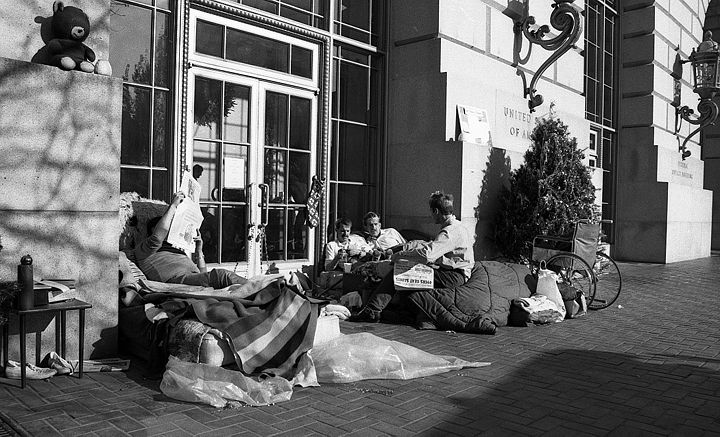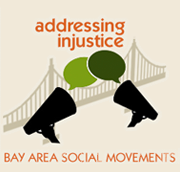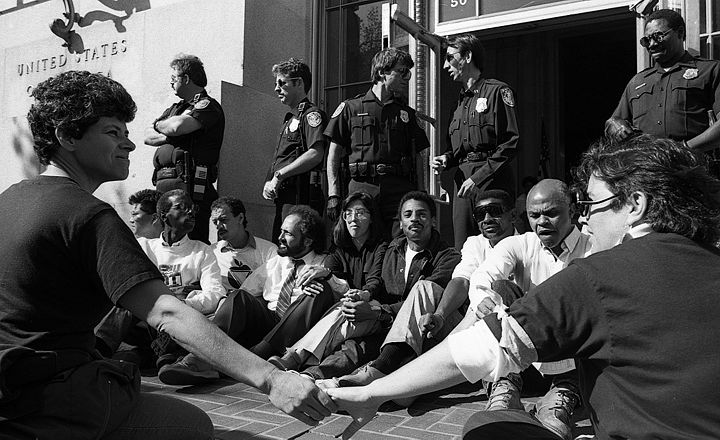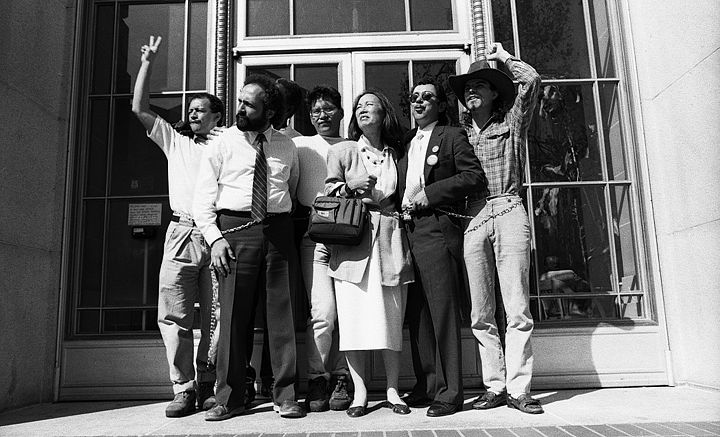AIDS/ARC Vigil 1985-1995: Difference between revisions
(added link to new AIDS piece) |
m (Text replacement - "category:Gay and Lesbian" to "category:LGBTQI") |
||
| Line 61: | Line 61: | ||
''Adapted from "Frank Bert and Steven Russell 1985 Start ARC/AIDS Vigil at U.N. Plaza," in "Backtracking" 199485 #9 of 9'' | ''Adapted from "Frank Bert and Steven Russell 1985 Start ARC/AIDS Vigil at U.N. Plaza," in "Backtracking" 199485 #9 of 9'' | ||
[[category:1980s]][[category:1990s]][[category:Dissent]][[category:Civic Center]][[category: | [[category:1980s]][[category:1990s]][[category:Dissent]][[category:Civic Center]][[category:LGBTQI]][[category:Homeless]][[category:Public Health]] [[category:Bay Area Social Movements]] | ||
Latest revision as of 07:09, 16 October 2018
Historical Essay
By Libby Ingalls
June 15, 1990—Activists from the ARC/AIDS Vigil chain themselves to the entrance of the old Federal Building in San Francisco's Civic Center in a 24/7 vigil demanding greater action by the US government to combat the AIDS epidemic.
Photo: Rick Gerharter
| The AIDS/ARC Vigil of 1985-1995 remains the longest running act of civil disobedience in San Francisco. It began on a small scale when two men, Steven Russell and Frank Bert, chained themselves to the door of the Federal Building in UN Plaza to protest the government’s inaction in the face of the devastating AIDS virus that had already infected half the gay male population in San Francisco. A group of supporters gathered, and thus began the 24-hour a day vigil that lasted ten years. Over the decade it evolved into a full-service encampment, providing information, counseling, food, and emergency housing to the sick and disenfranchised, touching the lives of hundreds, providing a supportive community, empowering folks who had given up, and inspiring HIV/AIDS activism. |
The Vigil had four demands: a government appropriation of $500 million in direct AIDS research; benefits for people with AIDS Related Conditions (ARC); FDA approval for American physicians to prescribe medicines and treatments of ARC and AIDS that were available in other countries; and (a demand included later) for President Reagan and government officials to publicly condemn discrimination against AIDS and ARC, to repudiate the fear and hatred causing hysteria, and to provide accurate information.
March 8, 1988—Activists in support of the ARC/AIDS Vigil block the entrance to the old Federal Building in San Francisco's Civic Center before their arrest.
Photo: Rick Gerharter
The dedicated group of men and women, though mostly of homeless and nearly homeless gay men, slept in tents, cooked in a well-equipped kitchen, and staffed a table that provided educational information, 24-hour a day services, and support to the community.
The challenges were many. That first winter was bitterly cold and rainy, particularly hard for people with a compromised immune system. Tents were flattened and the ground turned to mud. There was constant homophobic harassment and name calling by passers-by, and one cold night city cleaners hosed them.
Kindness and generosity prevailed, though. Bars, restaurants, theatres, and hotels offered food, blankets, clothing, showers and facilities. Individuals donated money, food, tents, and clothing. The Guardian Angels provided security. And doctors visited the site daily to provide free medical care.
The Vigil grew and gradually developed an outreach program to the people in the plaza and a reputation within the community as a place where a person could come to talk about AIDS or ARC issues in a safe, unstructured environment. Within four months there were 100 people coming and going. Though not achieving their four goals, the Vigil had raised consciousness of the plight of people suffering from AIDS and gained many supporters. The Board of Supervisors passed a resolution endorsing the action, fairly radical as the Board was sanctioning an act of civil disobedience in violation of federal law. The Board also made it city policy to offer proper treatment and financial assistance for people with ARC. Members of the Vigil were invited to testify before agencies and committees of San Francisco, then the State of California, and finally the federal government. The response was gratifying on the local level, less successful with the state, and a failure on the federal level.
March 8, 1988—Third world activists in support of the ARC/AIDS Vigil chain themselves together to block the entrance to the old Federal Building in San Francisco's Civic Center before their arrest.
Photo: Rick Gerharter
With growth came other challenges: money was stolen, there was political infighting, and freeloaders and street people moved in to take advance of free food and shelter. Vigil participants began lobbying for their own causes, and then accusing each other of taking advantage of the Vigil for personal and political purposes. The loose gathering of Vigil participants realized they needed an organized structure and leadership to get back on track.
They started by labeling themselves the Family and vowed to return to the original spirit of the group, one of love. Anyone who supported the Vigil was welcome, but Vigil Family membership was restricted to those who gave ten hours a week of work to the group, such as in security, community service, desk duty, cleanup, or cooking. They opened a bank account, formed committees to take care of daily tasks, and continued to spread the word on the plight of individuals with AIDS/ARC and on the political and medical issues. Outreach to the community, disseminating information and helping people take charge of their lives began to spread ever wider.
The Vigil continued, but so did the storms, internal fighting, demoralizing times, gay bashing, and the ubiquitous illness and death. The spirit of the Vigil kept bounding back, though, ever stronger with each crisis. As their sign read, ”We rely on love,” a constant reminder. The only time federal officials attempted to have the Vigil removed from federal property, a thousand supporters showed up, and the feds backed off.
The central location of the Vigil, round-the-clock operation, and experience organizing on the street level proved valuable in collaborating with other groups to fight anti-gay issues, staff booths, and participate in direct actions. But throughout, their own focus remained on social responsibility and empowering people to take charge of their lives. They distributed information pamphlets on AIDS, drug use, women and AIDS, and political issues. They provided survival sheets and referrals to different community centers, guidance and understanding. And not least, they invited the involvement of community people. Their philosophy was “Get up off your death bed,” and with that they assigned folks different jobs within the Vigil, showing each he had something to contribute, giving them a sense of worth and purpose.
In 1990 the Vigil contracted with the City to provide street-based outreach to the community, saving the city hundreds of thousands of dollars. The Vigil received no public money but relied solely on private donations. Their main clients were the disenfranchised sick and prostitutes, and their success was largely a result of the safe setting and feeling of trust they gave clients, with no fear of judgment.
10-27-1990, A supporter of the ARC/AIDS Vigil at the old Federal Building in San Francisco's Civic Center lights a memorial candle on the 5th anniversary of the 24/7 vigil, demanding increased action by the US government in the AIDS epidemic.
Photo: Rick Gerharter
By 1995 the inhabitants of the Vigil had shrunk from 20 to three, and after the multitude of challenges they had faced, it was a December storm that destroyed the tents and closed the encampment. So what effect did the Vigil have over those ten years? The most tangible contribution was on the local level, the help and support it gave to countless individuals, be it medical, psychological, emotional, or social. The Vigil provided a way forward, a sense of purpose, and a support community for those previously struggling alone.
On the wider political front, their voice was one of many pressuring the federal government to take action. Significant federal recognition came in 1987: AZT came on the market: the federal government announced an approval of $30 million to purchase AZT f or the uninsured; and the National Institute of Allergy and Infectious Disease formed the AIDS Clinical Trial Group. Laws against discrimination followed, along with the approval of improved anti-HIV drugs. The National Commission on AIDS was established in 1988, signed by President Ronald Reagan. In the years to follow nearly every state created a gubernatorial-level task force or commission on AIDs. The Ryan White Comprehensive AIDS Resources Emergency Act of 1990 assured funding for treatment for the uninsured and underinsured, and continues today.
The form of direct action that was called for in 1985 was no longer relevant in 1995, but for ten years, the Vigil was part of a movement that brought the City closer to the day the Vigil inhabitants could all go home.
Adapted from "Frank Bert and Steven Russell 1985 Start ARC/AIDS Vigil at U.N. Plaza," in "Backtracking" 199485 #9 of 9





